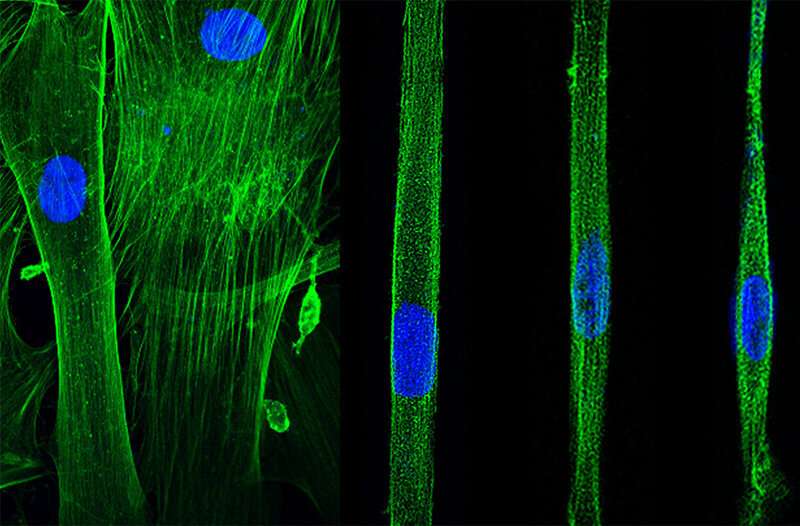Protein nanoclusters protect cells from stressful forces, and diseases such as muscular dystrophy

Scientists at the USC Dornsife College of Letters, Arts and Sciences found that emerin responds to harmful mechanical forces on the cell by bunching together to form so-called "nanoclusters."
- The emerin nanoclusters help stabilize and protect the nuclear envelope, the membrane surrounding the nucleus, from damage and rupture.
- The nucleus houses the cell's genetic material and the machinery that translates DNA's genetic code into proteins.
- Emerin comes together with other proteins in the nuclear membrane to help maintain the membrane's shape and integrity.
In their words:
"The rearrangement of emerin into nanoclusters is crucial for properly adapting the nucleus to mechanical stress. In fact, cells without emerin or with defective emerin assemblies could not properly respond to mechanical stress," says Fabien Pinaud, associate professor of biological sciences and physics and astronomy at USC Dornsife and corresponding author.
Also important: Emerin is a key molecular player in cells' ability to cope with mechanical stress and must function normally for cells to properly respond to those forces.
- The researchers found that mutant forms of emerin known to cause EDMD were unable to correctly self-assemble, causing the cell nucleus to be "impotent in its response to mechanical challenges."
- These results provide further evidence and understanding of emerin's role in EDMD.
Emery-Dreifuss muscular dystrophy is a rare genetic disease affecting muscles.
- Symptoms usually begin to show by age 10 and progressively worsen with time.
- Early symptoms include weakness and degeneration of leg, arm and shoulder muscles as well as stiff joints. Later, the heart often is affected as well as muscles involved in breathing.
- Patients frequently become dependent on a wheelchair and other assistance, and usually die by mid-adulthood.
To test the role of emerin, Anthony Fernandez and other graduate students in the Pinaud lab induced mechanical stress on cells by forcing them to take unusual rectangular shapes, then used highly advanced microscopy techniques to see how emerin responded.
- The researchers were able to produce images of emerin in cells at resolutions never achieved before.
- The ultrahigh-resolution images revealed how emerin rearranges at a molecular scale of just a few nanometers, according to Pinaud.
"Shaping the cells' silhouette and using highly advanced microscopy techniques were both key to showing that the reorganization of emerin on a scale of a few nanometers is critical for cell adaptation and to survive changes in mechanical conditions, such as one would find when muscles are working," Pinaud said.
Pinaud says the research provides deeper insight into the importance of the nucleus in responding to mechanical stress on cells.
"The average person generally thinks of the nucleus as simply housing our genetic material," he said. "Our findings show how important the nucleus is to the cell's mechanical response, and that the nucleus itself must be able to adapt to mechanical challenges to prevent cell injury and death."
Pinaud says the study also demonstrates the important role advanced imaging plays in revealing how cellular processes work and may lead to disease.
"Importantly, we showed that these crucial reorganizations take place over just a few tens of nanometers, a length scale that remains inaccessible by conventional optical microscopy imaging," he said. "Our results underline the importance of peering into biological processes with the highest possible optical resolution and looking within intact cells to better comprehend fundamental cell biology systems and the onset of diseases."
Pinaud says the team wants to know more about the forces that act on the nuclear membrane and the role of other proteins in helping cells respond to mechanical forces.
- The team is developing methods that use light to directly measure the forces exerted on the nuclear membrane. These forces are in the range of a few tens of piconewtons—about 1 billion times less than the force needed to keep a dollar bill from falling to the ground.
- They also want to explore the interaction of emerin with the LINC complex—a group of cell proteins that plays multiple vital roles, including sensing forces on the cell.
The study is published in the Journal of Cell Science.
More information: Anthony Fernandez et al, Emerin self-assembly and nucleoskeletal coupling regulate nuclear envelope mechanics against stress, Journal of Cell Science (2022). DOI: 10.1242/jcs.258969
Journal information: Journal of Cell Science
Provided by University of Southern California



















